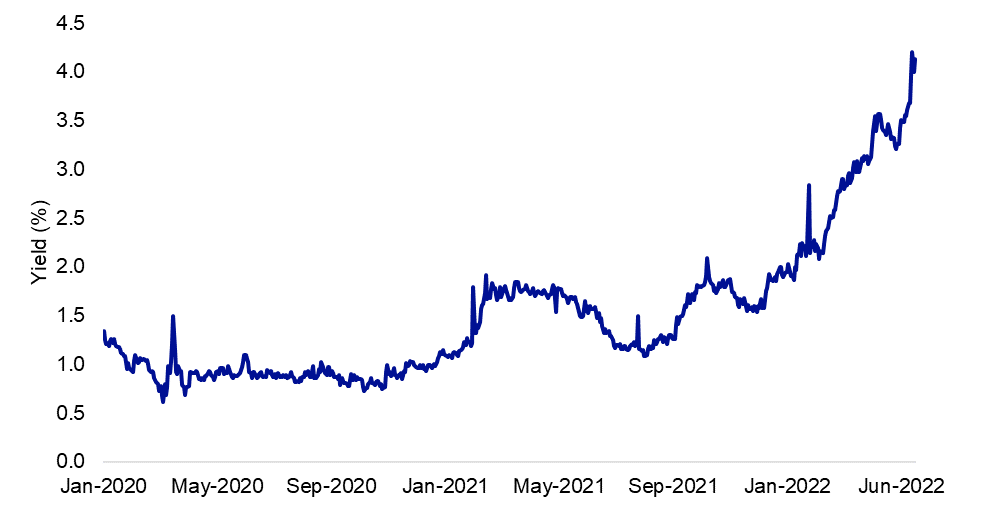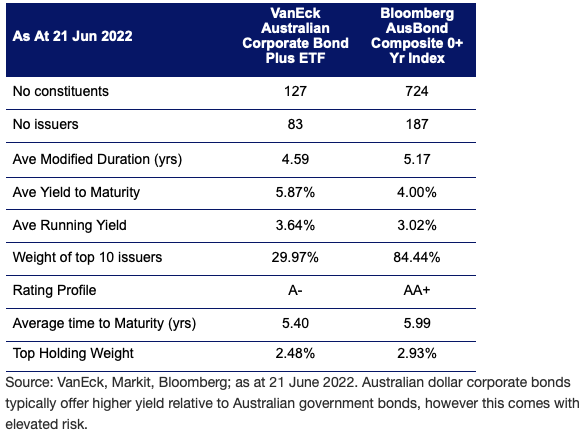A year ago, investors were questioning the prudence of the 60-40 blend and no one was predicting that, entering the 2022/23 financial year, they would be increasing their allocation to bonds, but here we are. Bonds are cool again. Rates, driven by high inflation, have risen. The long end of the curve, 10-year bonds’ yield is in excess of 4%, up from 2.6% this time last year.
Bond prices have plunged, Australia’s Bond Index, the Bloomberg AusBond Composite Bond Index 0+ years (AusBond Composite) has suffered a maximum drawdown of 12.70%, its biggest ever fall, well beyond the falls of the 1994 bond crash. In addition to falling bond prices, credit spreads have widened and they are now beyond their March 2020 levels. Bonds are starting to look attractive again. Yields have increased and there are potential opportunities for investors looking to increase their allocation to bonds, especially in corporate bonds.
The market is pricing rate rises into the end of the year
Looking at interest rate futures, the implied Australian cash rate after the RBA’s December meeting sits beyond 3.50%. This requires aggressive interest rate moves over the next six months.
Figure 1: Interest rate probabilities

Australian 10-year yields have gone even further
The graph below shows the yield of Australian Government 10-year bonds have moved beyond 4%.
Figure 2: Australian Government Bond 10-year yield

Source: Bloomberg, 20 June 2022
The market may have oversold longer dated bonds. If they have, it may be time for investors to consider bonds.
As yields have been increasing, bond prices have fallen. At the same time, credit spreads have widened, this has put further pressure on corporate bonds. The spreads on corporate bonds are now as wide as they were in March 2020, at the peak of the COVID-19 crisis.
Accessing the yield while limiting duration (interest rate) risk
With bonds having fallen 12% since the end of 2020, there may be pockets of ‘value’ for investors seeking income with attempting to preserve capital. One way it may be prudent for investors to consider bonds is to shorten the duration of their fixed-term bond investments to mitigate the impact of rising interest rates and target higher rated bonds to mitigate credit risks.
The bonds with the greatest duration risk are long-end fixed term bonds. Duration risk measures the sensitivity of a bond to changes in interest rate movements. For example, if the duration of a bond is 4, it means that with a 1% rate rise, the value of the bond would fall 4%. A bond with a duration of 2 would only fall 2% on a 1% rate rise.
Short dated over long dated securities
The VanEck Australian Corporate Bond Plus ETF (PLUS) provides a diversified, investment-grade credit exposure but features a shorter duration than the AusBond Composite. PLUS had an average modified duration of 4.59 as at 21 June compared to 5.17 years for the for the AusBond Composite.
Not only that, it’s yield, or income return, is higher with an average yield to maturity of 5.87% as at 21 June 2022, compared to 4.00% for the benchmark. Currently, PLUS holds only investment grade bonds and has an average credit rating of A-.








